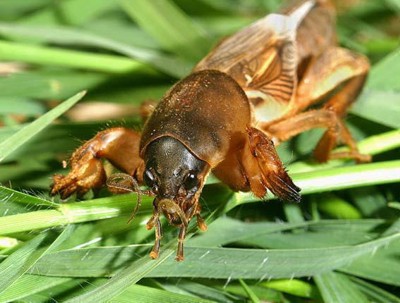Pests
Gryllotalpa africana Palis. - African Mole Cricket
Synonyms.
Gryllotalpa orientalis Burm., Gryllotalpa fossor Scudd.Systematic position.
Class Insecta, order Orthoptera, suborder Ensifera, superfamily Grylloidea, family Gryllotalpidae, genus Gryllotalpa.Biological group.
Polyphagous pest.Morphology and biology.
Body length is 25-33 mm. Body is yellow-brown, light yellow beneath. Antennae are short, filiform. Forelegs are digging; lower part of front femur is almost straight. Pronotum is large, oblong. Forewings are reaching apex of the abdomen. Wings project from under forewings in the form of wisps. Forefemora are slightly thickened and slightly excavated from below. Upper inner part of hind tibiae bears 3-4 spines. Female is devoid of ovipositor. The mole crickets mate underground; then the female builds a nest in clay soil at the depth of 0.3-0.4 m and lays 220 elongate-oval eggs. Embryonic development lasts 10 to 12 or more days. Larvae pass 6 instars. Third to fifth instar larvae and adults overwinter in soil at the depth of 0.8-1.2 m. The complete cycle of development lasts 1 to 3 years depending upon climatic conditions. Natural habitats include moistened humus-enriched biotopes, such as river flood-lands and banks of ponds, as well as irrigated or well fertilized fields and vegetable gardens.Distribution.
G. africana is distributed in Japan, China, Middle Asia; in South and Southeast Asia, Indonesia, India, Africa, Australia, Philippines; on the former USSR territory, viz in Kazakhstan, Uzbekistan, Turkmenistan, Tajikistan, and Kyrgyzstan; in Russia it is found in Amur Region, in the south of Khabarovsk Territory, in Sakhalin Region, on Kunashir Island, in Ussuriisk and other districts of Primorskii Territory, as well as in the Urals.Ecology.
The Mole Cricket dwells in humid soil, making galleries. Insects fly in evening and at night; they fly toward light. They also swim well. In warm weather the insect burrows holes near the ground surface, while in winter the hole depth reaches 50-100 cm. Mass emergence after wintering is usually observed at the temperature 12-15°C. Normal egg development requires 100% humidity. Hatching larvae remain in their nest, guarded by the female for 2-3 weeks. Feeding and burrowing holes under ground, the Mole Cricket gnaws through the roots of plants, eating away tubers and rhizomes. It also feeds on many soil invertebrates, including insects and earthworms. Natural enemies are birds (rooks, starlings, etc.), insectivorous mammals (shrews, moles), ants (destroying eggs), carabids (feeding on larvae), nematodes of the genera Oxyurius and Telestomum, mites of the genera Neothorombium, Caloglyphus, and Rhizogliphus. Fungal diseases may cause mass death of the pest during winters with thaws.Economic significance.
Larvae and adults of the Mole Cricket gnaw plant roots, tubers and edible roots, damaging wheat, oats, barley, rice, soya, vegetable crops, maize, potato, and sugar beet. It causes damage in hotbeds; in nurseries and young gardens it damages fruit trees. Control measures include deep autumn plowing and inter-row treatments of soil, trapping in a winter period, as well as application of chemicals and poisoned baits, soil fumigation.Reference citations.
Gerasimov B.A., Osnitskaya E.A. 1961. Mole Cricket (Gryllotalpa gryllotalpa L.). In: Pests and deceases of vegetable culture. Moscow: Sel.khozgiz, p. 380-382 (in Russian).Mishchenko L.L. 1972. Order Orthoptera. In: Kryzhanovskii O.L., Dantsig E.M., eds. Insects and mites are pests of crops. V. 1. Exopterygotes. Leningrad: Nauka, p. 45-46 (in Russian).
Shchegolev V.N. 1964. Entomology. Moscow: Vysshaya shkola, p. 86-87 (in Russian).
Storozhenko S.Yu. 1986. Order Orthoptera (Saltatoria). In: Ler P.A., ed. Keys to insects of the Far East of the USSR. V. 1. Apterous, Paleoptera, Exopterygotes insects. Leningrad: Nauka, p. 241-316 (in Russian).


